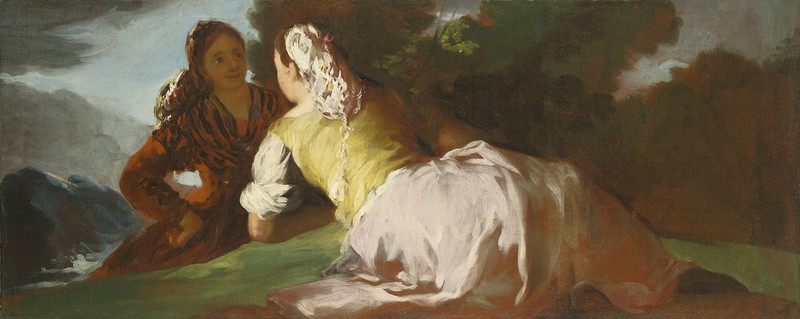- Cronología
- Ca. 1790 - 1793
- Ubicación
- Wadsworth Atheneum Museum of Art, Hartford, United States
- Dimensiones
- 59 x 145 cm
- Técnica y soporte
- Oil on canvas
- Reconocimiento de la autoría de Goya
- Undisputed work
- Titular
- Wadsworth Atheneum Museum of Art
- Ficha: realización/revisión
- 25 Apr 2010 / 14 Jun 2023
- Inventario
- (1929.4)
- Otros títulos:
-
Two Majas Gossiping (Dos majas conversando)
Two Women in Conversation (Dos mujeres en una conversación)
This canvas may have belonged to Sebastián Martínez in Cádiz. Later it would have gone to the Marchioness of Bermejillo del Rey, in Madrid, and from there to Kart M. Stern. It subsequently belonged to the Viscount of Heudencourt in Paris and them to Durlacher Bros., in New York.
In 1929 it was donated to the Wadsworth Atheneum Museum of Art by Ella Gallup Summer and Mary Catlin Summer.
Trapier considers, based on the testimony of Nicolás de la Cruz, Count of Maule, that this work could have been one of the three overdoor pieces painted for Sebastián Martínez, the art dealer and ilustrado in whose Cádiz home Goya spent several months between 1792 and 1793. The two other works commissioned at the same time would therefore have been Sleepy Woman and The Dream, this last one being smaller in size, probably after being cut down.
The painting Gossiping Women brings to mind the cartoons that Goya made between 1775 and 1792 for the Royal Textile Factory of Santa Bárbara, costumbrista and pastoral scenes which had to be sufficiently simple in their designs so as to permit their later conversion into tapestries. In fact, some believe that this painting could have been the cartoon for a tapestry which has either been lost or which was never made.
We can see two reclining women talking in the countryside, one in front of the other, dressed in elegant clothes, leading us to believe that they are not far from the city. The fact that the topic of conversation is an interesting one is made clear by the rather surprised and intrigued expression of the woman who is facing the viewer, dressed in a reddish-coloured outfit.
In this painting, Goya makes use of quick, loose brushstrokes, recalling some of Velázquez's work (Seville, 1599-Madrid, 1660). He has managed to skilfully capture the quality of the fabrics and their folds, lingering in particular over the pink skirt of the woman in the foreground. It is possible that one of the sources that inspired this painting could have been Velázquez's The Toilet of Venus (La Venus del espejo) (Ca. 1648, National Gallery, London), which Goya would have seen when it was in the collection of the Duke and Duchess of Alba.
See rec. no.
-
GoyaKoninklijk Kabinet van Schilderijen MauritshuisThe Hauge1970organized by Ministerio de Estado y Asuntos Culturales and Réunion des Musées Nationaux, July 4th to September 13th 1970. Exhibited also at the Musée de l’Orangerie des Tuileries, Paris, October 25th to December 7th 1970, consultant editors Jeannine Baticle and A. B. de Vriescat. 4
-
Goya and the art of his timeMeadows MuseumDallas1983consultant editor Edward J. Sullivan. From December 7th 1983 to February 6th 1983cat. 15
-
Goya. 250 AniversarioMuseo Nacional del PradoMadrid1996consultant editor Juan J. Luna. From March 29th to June 2nd 1996cat. 77
-
L'œuvre peint de Goya. 4 volsParís1928-1950p. 215, cat. 179
-
Goya and his sittersNew YorkThe Hispanic Society of America1964p. 9, il. 17
-
Vie et ouvre de Francisco de GoyaParísOffice du livre1970p. 100, cat. 307
-
BarcelonaPolígrafa1970vol. I, p. 287, cat. 321
-
L’opera pittorica completa di GoyaMilanRizzoli1974p. 104, cat. 243
-
Francisco de Goya, 4 vols.ZaragozaCaja de Ahorros de Zaragoza, Aragón y Rioja1980-1982vol. IV, p. 90
-
Goya. 250 AniversarioMadridMuseo del Prado1996pp. 164 (il.), 355 y 356, cat. 77
